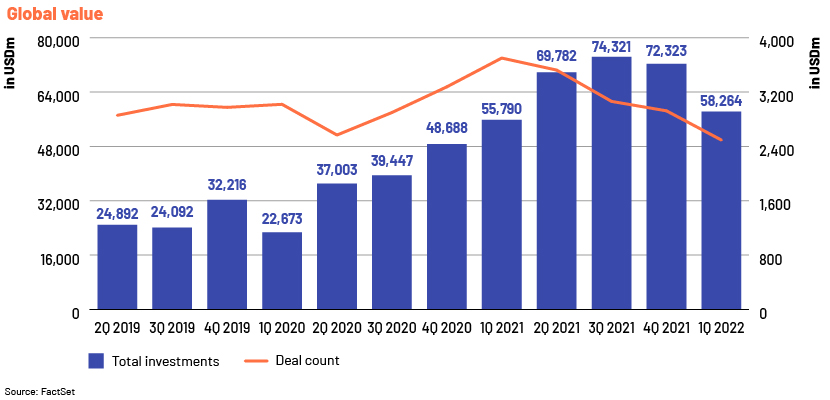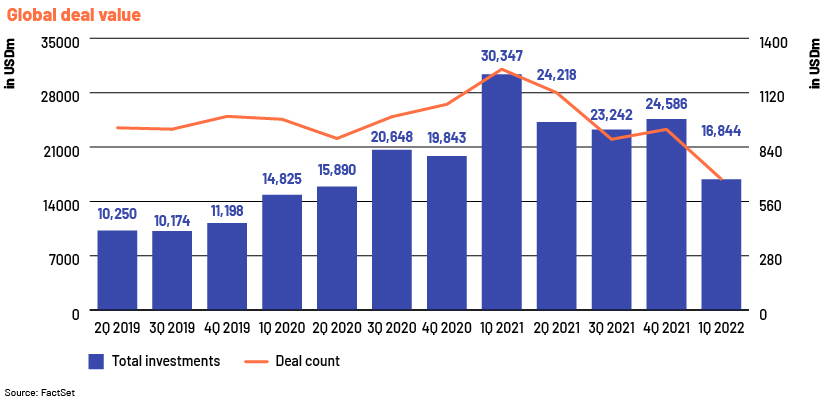Published on August 11, 2022 by Proshoon Sikdar
Private equity (PE) deal making surpassed previous highs in 2021. This was driven by a robust recovery in 2H 2020, when PE broke previous records for transaction volume and deal value. PE funds are estimated to have USD2.3tn in dry powder, and well-known companies are raising large funds, resulting in strong capital supply expected to last throughout its growth trajectory. Unsurprisingly, activity in 1Q 2022 slowed after such a performance.
Some key factors that drove the business:
Rise of technology:
Technology and digitisation have entered mainstream corporate strategy, resulting in the need for technology strategy. Another vertical moving rapidly is the cybersecurity space, with companies having transitioned to working from home. The percentage of PE activity represented by tech transactions increased sharply in 2021. PE tech deals spiked in 2021, with over USD400bn in tech investments in the US compared to USD196bn in 2020 and USD146bn in 2019. Significant transactions included Thoma Bravo's USD10.1bn purchase of Proofpoint, a group of PE investors' USD14bn purchase of McAfee, and Bain Capital and Hellman & Friedman's USD17bn purchase of Athenahealth. The recent announcement of a USD16.5bn deal between Vista Equity Partners and Elliott Investment Management to take Citrix private is a sign of the continued strength of PE activity in the technology sector in 2022, fuelled in part by trends in digital adoption accelerated by the pandemic.
Exit via special-purpose acquisition company (SPAC):
SPAC IPOs were priced at a staggering pace in 1Q 2021; 298 SPAC IPOs raised c.USD88bn, exceeding the c.USD83bn raised by 248 SPAC IPOs in 2020. One-third of the SPACs listed in 2020 and one-third of those listed in 2021 targeted the technology, media, and telecom (TMT) sector, far more than those than targeted other sectors. At least 117 TMT companies combined with SPACs to go public in 2021, raising a total of USD67.1bn. The biggest SPAC merger IPOs in TMT were Lucid Motors (raised USD4.6bn), Grab (raised USD4.5bn) and SoFi (raised USD2.4bn). Healthcare SPACs, on the other hand, are expected to face a strained environment in 2022 due to tighter regulation and uneven performance. Healthcare SPACs raised USD11.1bn in 2020 and USD23.1bn in 2021. Major SPAC merger IPOs in healthcare in 2021 were MultiPlan (raised USD11.1bn), Clover Health (raised USD828m) and Cano Health (raised USD690m). The exit path through SPACs has taken a hit recently, primarily due to underperformance by post-de-SPAC target companies and increased scrutiny by the Securities and Exchange Commission (SEC), with changes in accounting guidance and key enforcement actions brought by the SEC against SPACs, their sponsors and/or target company executives.
Despite uncertainties, SPACs will likely remain a popular exit strategy for PE investors. There are 575 SPACs looking for targets at present, further motivated by strong incentives to close deals before the time periods outlined in their charters expire.
Return of club deals:
PE club deals disappeared after the financial crisis of 2008-09, but they are now making a comeback as PE firms seek to invest sizeable amounts of capital in deals with sizeable targets and strategic purchasers deal with an unclear regulatory landscape. The USD34bn purchase of Medline by Blackstone, Carlyle and Hellman & Friedman in 2021 marked the largest buyout involving a group of PE firms since the financial crisis. Even well-known activist investors such as Starboard collaborated with an investor group to make a bid for Kohl's. More large deals are expected, stimulated by available capital pools, high valuations and the willingness of sponsors to collaborate with each other and other classes of investors.
Rebound in fundraising activity:
PE fundraising bounced back in 2021, reaching record levels by year-end with c.USD940bn raised. Hellman & Friedman raised USD24.4bn for its 10th buyout fund, KKR USD15bn for its fourth Asia fund and Bain Capital USD11.8bn for its latest flagship North America buyout fund. The trend was expected to continue in 2022 as major PE players planned to raise additional capital, that would have resulted in record funds and unprecedented levels of deployable capital. However, activity slowed in terms of number of deals in 1Q 2022, when c.7,100 PE deals were concluded, worth USD200bn in aggregate. This represented a 25% drop in deal count, but deal value increased 15.8% from 1Q 2021.
Growth in EESG initiatives:
Employee, environmental, social and governance (EESG) considerations have continued to gain momentum in the PE space as investors and asset managers have increasingly recognised EESG as a lever for value creation. A number of PE firms have launched impact funds for EESG-oriented investments, and according to recent surveys, investors are willing to allocate more capital to sustainable investments.
TMT sector
The technology sector received the most PE/venture capital (VC) investments in 2021, and investments in the fintech space rose significantly. Investments grew at a CAGR of 125% over the past five years, driven primarily by investments in the payment ecosystem, with the emergence of new segments such as decentralised finance (DeFi). Neo-banking has emerged as the fastest-growing subsector, recording 20x growth in investments. Funding in the blockchain sector grew to USD25.2bn in 2021. The software space was the hottest, attracting c.5,600 deals worth almost USD43bn since mid-2020. This was followed by the interactive media and services sector, which saw c.900 deals worth USD52bn. 1Q 2022 saw c.2,500 deals worth USD58.3bn, representing growth of 4.4% in deal value and a decline of 33% in volume over 1Q 2021.
TMT sector’s attractiveness:
-
Attractive business models such as software-as-a-service (SaaS) or subscription-based data services are asset-light, predictable and generate high cash flow, with gross margins as high as 80%. A capability once developed can be sold multiple times.
-
Resilience under extreme business situations such as the pandemic has made PE firms confident in their sustainability. Tech companies benefited amid the crisis as other sectors started transitioning to digital platforms or enhancing their tech infrastructure.

Healthcare sector
In the second year of the pandemic, healthcare PE activity showed its resilience to the significant disruption in the market, posting a record year for deal making. This was partially fuelled by a pandemic-induced backlog of parked deals and the resurgence of megadeals, mainly the USD34bn Medline deal and the USD17bn acquisition of Athenahealth. The number of deals increased 36% to 515 from 380 in 2020. Total disclosed value more than doubled to USD151bn from USD66bn. The average disclosed deal value surged 134%, mainly because of five buyouts larger than USD5bn, compared with just one in 2020. The biotechnology space attracted c.2,100 deals valued at c.USD86bn since mid-2020, followed by healthcare technology at c.1,950 deals with a combined value of USD66.5bn. The pharmaceutical sector reported c.800 deals during the period. 1Q 2022 saw c.670 deals worth USD16.8bn, representing a decline of 44.5% in deal value and a decline of 45.7% in volume from 1Q 2021.
Healthcare sector’s attractiveness:
-
Global spending on health services has grown around 5% y/y. The sector is recovering from the effects of the pandemic with services returning to normal levels. With COVID-19 vaccines in full production and confidence of increased immunity, consumers are returning to visit doctors in person. Additionally, healthcare investment banks are playing a crucial role in driving deals and facilitating access to capital for PE and VC firms exploring healthcare opportunities.
-
The digitisation of healthcare deliverables also presents a major opportunity. While markets in general have indicated a recession, healthcare continues to produce returns due to its resilience. Bain & Company states that PE investments in healthcare during previous recessions were nearly 50% more than in other sectors.
-
The healthcare sector provides PE firms with potential for add-on investment. With the multiple elements in the ecosystem, PE firms could acquire additional assets to build a continuum of care.

Current scenario
The Russia-Ukraine conflict will likely have a modest impact on private markets, primarily because asset managers and institutional investors were quick to exit from Russia, either in an effort to comply with ESG standards or due to sanctions. On the other hand, the rising interest rate environment is likely to slow deal activity for PE firms, making them look to hedge their interest rate risk accordingly.
Outlook
As investors continue to navigate the challenging market conditions, private investments would provide a cushion. The impact of inflation and interest rates, the profound effects of megatrends such as digitisation and decarbonisation and sub-themes across sectors will likely define the PE scenario for the remainder of 2022. The markets have so far been quite turbulent due to macro factors ranging from inflationary pressures to geopolitical tensions in Eastern Europe. Global volatility has spiked to its highest levels since October 2020, leading to a significant decrease in equity issuance across sectors. The Fed increased interest rates by 25bps for the first time since 2018; this is expected to be followed by another five or six rate hikes this year. However, risk premium in private markets is attractive and offers portfolio resilience. With the amount of dry powder available, combined with the number of funds in the market and the considerable interest in the asset class and its performance, 2022 is expected to be a strong year for investments and exits.
How Acuity Knowledge Partners can help
We provide VC firms with comprehensive support across the investment life cycle and help them keep abreast of changes in consumer behaviour and economic and demographic trends in both existing and emerging markets. We also offer horizontal support across middle-office and back-office operations to PE firms on the investment side. Our services range from portfolio management and advising to deal finding and target selection. Our teams have expertise in using Preqin, FactSet, CB Insights, Crunchbase, SimilarWeb, App Annie, Venture intelligence, PitchBook and other important sector-specific sources.
Sources:
The trend was expected to continue in 2022 as major PE players planned to raise additional capital, that would have resulted in record funds and unprecedented levels of deployable capital.
https://www.mizuhogroup.com/americas/insights/2022/04/equity-capital-markets---tech-media
https://mergers.whitecase.com/highlights/global-pe-activity-slows-in-q1-following-blockbuster-year#!
https://www.bain.com/insights/year-in-review-global-healthcare-private-equity-and-ma-report-2022/
https://www.blackrock.com/institutions/en-us/insights/investment-actions/2022-private
https://www.spglobal.com/marketintelligence/en/news-insights/blog/insight-weekly-april-12-2022
https://corpgov.law.harvard.edu/2022/02/09/private-equity-2021-year-in-review-and-2022-outlook/
https://www.clearwaterinternational.com/publications/clearwater-international-multiples-heatmap
https://www.privateequityinternational.com/private-equitys-growing-appetite-for-tech/
https://republic.com/blog/investor-education/popular-tech-startup-sectors-of-2022
https://citywireselector.com/news/private-markets-assess-the-impact-of-russias-invasion-of-ukraine
https://www.thestreet.com/investing/stocks/rising-rates-a-double-edged-sword-for-private-equity
https://www.spglobal.com/marketintelligence/en/news-insights/latest-news-headlines
https://www.verdict.co.uk/tmt-spac-reverse-merger-ipo-direct-listings/
https://www.spglobal.com/marketintelligence/en/news-insights/latest-news-headlines/
https://www.fiercehealthcare.com/special-report/spac-attack-10-biggest-healthcare
What's your view?
About the Author
Proshoon has 9+ years of experience in the investment banking domain. He is specialized in TMT with additional exposure to Healthcare and Consumer verticals.
Like the way we think?
Next time we post something new, we'll send it to your inbox







